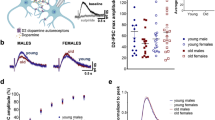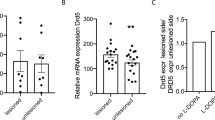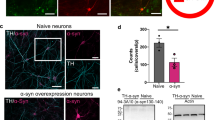Abstract
Parkinson disease is a neurodegenerative disorder whose symptoms are caused by the loss of dopaminergic neurons innervating the striatum. As striatal dopamine levels fall, striatal acetylcholine release rises, exacerbating motor symptoms. This adaptation is commonly attributed to the loss of interneuronal regulation by inhibitory D2 dopamine receptors. Our results point to a completely different, new mechanism. After striatal dopamine depletion, D2 dopamine receptor modulation of calcium (Ca2+) channels controlling vesicular acetylcholine release in interneurons was unchanged, but M4 muscarinic autoreceptor coupling to these same channels was markedly attenuated. This adaptation was attributable to the upregulation of RGS4—an autoreceptor-associated, GTPase-accelerating protein. This specific signaling adaptation extended to a broader loss of autoreceptor control of interneuron spiking. These observations suggest that RGS4-dependent attenuation of interneuronal autoreceptor signaling is a major factor in the elevation of striatal acetylcholine release in Parkinson disease.
This is a preview of subscription content, access via your institution
Access options
Subscribe to this journal
Receive 12 print issues and online access
$209.00 per year
only $17.42 per issue
Buy this article
- Purchase on Springer Link
- Instant access to full article PDF
Prices may be subject to local taxes which are calculated during checkout








Similar content being viewed by others
References
Albin, R.L., Young, A.B. & Penney, J.B. The functional anatomy of basal ganglia disorders. Trends Neurosci. 12, 366–375 (1989).
Freund, T.F. et al. Efferent synaptic connections of grafted dopaminergic neurons reinnervating the host neostriatum: a tyrosine hydroxylase immunocytochemical study. J. Neurosci. 5, 603–616 (1985).
Nastuk, M.A. & Graybiel, A.M. Patterns of muscarinic cholinergic binding in the striatum and their relation to dopamine islands and striosomes. J. Comp. Neurol. 237, 176–194 (1985).
Barbeau, A. The pathogenesis of Parkinson's disease: a new hypothesis. Can. Med. Assoc. J. 87, 802–807 (1962).
Wooten, G. Parkinsonism. in Neurobiology of Disease (eds. Pearlman, A.L. & Collins, R.C.) Ch. 23, 454–468 (Oxford Univ. Press, New York, 1990).
MacKenzie, R.G., Stachowiak, M.K. & Zigmond, M.J. Dopaminergic inhibition of striatal acetylcholine release after 6-hydroxydopamine. Eur. J. Pharmacol. 168, 43–52 (1989).
DeBoer, P., Heeringa, M.J. & Abercrombie, E.D. Spontaneous release of acetylcholine in striatum is preferentially regulated by inhibitory dopamine D2 receptors. Eur. J. Pharmacol. 317, 257–262 (1996).
Yan, Z., Song, W.J. & Surmeier, J. D2 dopamine receptors reduce N-type Ca2+ currents in rat neostriatal cholinergic interneurons through a membrane-delimited, protein-kinase-C-insensitive pathway. J. Neurophysiol. 77, 1003–1015 (1997).
Maurice, N. et al. D2 dopamine receptor-mediated modulation of voltage-dependent Na+ channels reduces autonomous activity in striatal cholinergic interneurons. J. Neurosci. 24, 10289–10301 (2004).
Wichmann, T., Wictorin, K., Bjorklund, A. & Starke, K. Release of acetylcholine and its dopaminergic control in slices from striatal grafts in the ibotenic acid-lesioned rat striatum. Naunyn Schmiedebergs Arch. Pharmacol. 338, 623–631 (1988).
Aosaki, T., Graybiel, A.M. & Kimura, M. Effect of the nigrostriatal dopamine system on acquired neural responses in the striatum of behaving monkeys. Science 265, 412–415 (1994).
Raz, A., Feingold, A., Zelanskaya, V., Vaadia, E. & Bergman, H. Neuronal synchronization of tonically active neurons in the striatum of normal and parkinsonian primates. J. Neurophysiol. 76, 2083–2088 (1996).
Calabresi, P. et al. Muscarinic IPSPs in rat striatal cholinergic interneurones. J. Physiol. (Lond.) 510, 421–427 (1998).
Yan, Z. & Surmeier, D.J. Muscarinic (m2/m4) receptors reduce N- and P-type Ca2+ currents in rat neostriatal cholinergic interneurons through a fast, membrane-delimited, G-protein pathway. J. Neurosci. 16, 2592–2604 (1996).
Zhang, W. et al. Characterization of central inhibitory muscarinic autoreceptors by the use of muscarinic acetylcholine receptor knock-out mice. J. Neurosci. 22, 1709–1717 (2002).
De Vries, L., Zheng, B., Fischer, T., Elenko, E. & Farquhar, M.G. The regulator of G protein signaling family. Annu. Rev. Pharmacol. Toxicol. 40, 235–271 (2000).
Ni, Y.G. et al. Region-specific regulation of RGS4 (regulator of G-protein-signaling protein type 4) in brain by stress and glucocorticoids: in vivo and in vitro studies. J. Neurosci. 19, 3674–3680 (1999).
Geurts, M., Hermans, E. & Maloteaux, J.M. Opposite modulation of regulators of G protein signalling-2 RGS2 and RGS4 expression by dopamine receptors in the rat striatum. Neurosci. Lett. 333, 146–150 (2002).
Geurts, M., Maloteaux, J.M. & Hermans, E. Altered expression of regulators of G-protein signaling (RGS) mRNAs in the striatum of rats undergoing dopamine depletion. Biochem. Pharmacol. 66, 1163–1170 (2003).
Rahman, Z. et al. RGS9 modulates dopamine signaling in the basal ganglia. Neuron 38, 941–952 (2003).
Hu, X.T., Wachtel, S.R., Galloway, M.P. & White, F.J. Lesions of the nigrostriatal dopamine projection increase the inhibitory effects of D1 and D2 dopamine agonists on caudate-putamen neurons and relieve D2 receptors from the necessity of D1 receptor stimulation. J. Neurosci. 10, 2318–2329 (1990).
Mileson, B.E., Lewis, M.H. & Mailman, R.B. Dopamine receptor 'supersensitivity' occurring without receptor up-regulation. Brain Res. 561, 1–10 (1991).
Kawaguchi, Y., Wilson, C.J., Augood, S.J. & Emson, P.C. Striatal interneurones: chemical, physiological and morphological characterization. Trends Neurosci. 18, 527–535 (1995).
Cooper, J.R., Bloom, F.E. & Roth, R.H. Biochemical Basis of Neuropharmacology 7th edn. (Oxford University Press, New York, 1996).
Esaki, T. et al. Developmental disruption of serotonin transporter function impairs cerebral responses to whisker stimulation in mice. Proc. Natl. Acad. Sci. USA 102, 5582–5587 (2005).
Joyce, J.N. Differential response of striatal dopamine and muscarinic cholinergic receptor subtypes to the loss of dopamine. II. Effects of 6-hydroxydopamine or colchicine microinjections into the VTA or reserpine treatment. Exp. Neurol. 113, 277–290 (1991).
Ueda, H. et al. Supersensitization of neurochemical responses by L-DOPA and dopamine receptor agonists in the striatum of experimental Parkinson's disease model rats. Biomed. Pharmacother. 49, 169–177 (1995).
Cabrera-Vera, T.M. et al. RGS9–2 modulates D2 dopamine receptor-mediated Ca2+ channel inhibition in rat striatal cholinergic interneurons. Proc. Natl. Acad. Sci. USA 101, 16339–16344 (2004).
Conklin, B.R. & Bourne, H.R. Structural elements of G alpha subunits that interact with G beta gamma, receptors, and effectors. Cell 73, 631–641 (1993).
Martin, E.L., Rens-Domiano, S., Schatz, P.J. & Hamm, H.E. Potent peptide analogues of a G protein receptor-binding region obtained with a combinatorial library. J. Biol. Chem. 271, 361–366 (1996).
Hamm, H.E. et al. Site of G protein binding to rhodopsin mapped with synthetic peptides from the alpha subunit. Science 241, 832–835 (1988).
Rasenick, M.M., Watanabe, M., Lazarevic, M.B., Hatta, S. & Hamm, H.E. Synthetic peptides as probes for G protein function. Carboxyl-terminal G alpha s peptides mimic Gs and evoke high affinity agonist binding to beta-adrenergic receptors. J. Biol. Chem. 269, 21519–21525 (1994).
Zeng, W. et al. The N-terminal domain of RGS4 confers receptor-selective inhibition of G protein signaling. J. Biol. Chem. 273, 34687–34690 (1998).
Golard, A. & Siegelbaum, S.A. Kinetic basis for the voltage-dependent inhibition of N-type calcium current by somatostatin and norepinephrine in chick sympathetic neurons. J. Neurosci. 13, 3884–3894 (1993).
Zamponi, G.W. & Snutch, T.P. Decay of prepulse facilitation of N type calcium channels during G protein inhibition is consistent with binding of a single Gbeta subunit. Proc. Natl. Acad. Sci. USA 95, 4035–4039 (1998).
Bennett, B.D., Callaway, J.C. & Wilson, C.J. Intrinsic membrane properties underlying spontaneous tonic firing in neostriatal cholinergic interneurons. J. Neurosci. 20, 8493–8503 (2000).
Pepperl, D.J., Shah-Basu, S., VanLeeuwen, D., Granneman, J.G. & MacKenzie, R.G. Regulation of RGS mRNAs by cAMP in PC12 cells. Biochem. Biophys. Res. Commun. 243, 52–55 (1998).
Inanobe, A. et al. Interaction between the RGS domain of RGS4 with G protein alpha subunits mediates the voltage-dependent relaxation of the G protein-gated potassium channel. J. Physiol. (Lond.) 535, 133–143 (2001).
Siderovski, D.P. & Willard, F.S. The GAPs, GEFs, and GDIs of heterotrimeric G-protein alpha subunits. Int. J. Biol. Sci. 1, 51–66 (2005).
Bernstein, L.S. et al. RGS2 binds directly and selectively to the M1 muscarinic acetylcholine receptor third intracellular loop to modulate Gq/11alpha signaling. J. Biol. Chem. 279, 21248–21256 (2004).
Xu, X. et al. RGS proteins determine signaling specificity of Gq-coupled receptors. J. Biol. Chem. 274, 3549–3556 (1999).
Goldberg, J.A. & Wilson, C.J. Control of spontaneous firing patterns by the selective coupling of calcium currents to calcium activated potassium currents in striatal cholinergic interneurons. J. Neurosci. 25, 10230–10238 (2005).
Reid, C.A., Bekkers, J.M. & Clements, J.D. Presynaptic Ca2+ channels: a functional patchwork. Trends Neurosci. 26, 683–687 (2003).
Dolezal, V. & Wecker, L. Muscarinic receptor blockade increases basal acetylcholine release from striatal slices. J. Pharmacol. Exp. Ther. 252, 739–743 (1990).
Graybiel, A.M., Aosaki, T., Flaherty, A.W. & Kimura, M. The basal ganglia and adaptive motor control. Science 265, 1826–1831 (1994).
LaHoste, G.J., Yu, J. & Marshall, J.F. Striatal Fos expression is indicative of dopamine D1/D2 synergism and receptor supersensitivity. Proc. Natl. Acad. Sci. USA 90, 7451–7455 (1993).
Tkatch, T., Baranauskas, G. & Surmeier, D.J. Kv4.2 mRNA abundance and A-type K+ current amplitude are linearly related in basal ganglia and basal forebrain neurons. J. Neurosci. 20, 579–588 (2000).
Skiba, N.P., Bae, H. & Hamm, H.E. Mapping of effector binding sites of transducin alpha-subunit using G alpha t/G alpha i1 chimeras. J. Biol. Chem. 271, 413–424 (1996).
Berman, D.M., Kozasa, T. & Gilman, A.G. The GTPase-activating protein RGS4 stabilizes the transition state for nucleotide hydrolysis. J. Biol. Chem. 271, 27209–27212 (1996).
Acknowledgements
The authors thank Y. Chen, Q. Ruan, K. Saporito, C. McCoy and S. Ulrich for technical assistance, and C.S. Chan and W. Shen for discussions. Supported by NS 34696 (D.J.S.), the Picower Foundation (D.J.S.), NS 37760 (C.J.W.), F32 NS 050900 (J.A.G.), MH45156 (P.L.), HD15052 (P.L.), the McKnight Foundation (P.L.), National Alliance for Research in Schizophrenia and Depression (P.J.E.) and MH065215 (P.J.E.).
Author information
Authors and Affiliations
Contributions
J.D. did most of the voltage-clamp and scRT-PCR experiments; he also participated in the writing of the manuscript and in the preparation of the figures. J.N.G. did the slice experiment examining the muscarinic modulation of interneuron spiking. T.T. designed all the primers and did the real-time RT-PCR experiment. J.A.G. and C.J.W. did the slice recording experiments examining the sensitivity of pacemaking to Ca2+ channel and SK channel block. S.C. and H.E.H. provided all the RGS proteins and peptides and did the GTPase activity assay. P.J.E. and P.L. generated the RGS4 OE mice. D.J.S. directed the project, prepared the figures and was responsible for the final manuscript.
Corresponding author
Ethics declarations
Competing interests
The authors declare no competing financial interests.
Supplementary information
Supplementary Fig. 1
RGS4 and 9 are different regulated in mice striatum tissues following domapine depletion by reserpine treatment. (PDF 334 kb)
Supplementary Fig. 2
Two dopamine depletion models produce same effect on M4 modulation of calcium channels. (PDF 1076 kb)
Rights and permissions
About this article
Cite this article
Ding, J., Guzman, J., Tkatch, T. et al. RGS4-dependent attenuation of M4 autoreceptor function in striatal cholinergic interneurons following dopamine depletion. Nat Neurosci 9, 832–842 (2006). https://doi.org/10.1038/nn1700
Received:
Accepted:
Published:
Issue Date:
DOI: https://doi.org/10.1038/nn1700
This article is cited by
-
A spiking computational model for striatal cholinergic interneurons
Brain Structure and Function (2023)
-
Striatal Rgs4 regulates feeding and susceptibility to diet-induced obesity
Molecular Psychiatry (2020)
-
Targeting the cholinergic system in Parkinson’s disease
Acta Pharmacologica Sinica (2020)
-
Comparison of effectiveness of trihexyphenidyl and levodopa on motor symptoms in Parkinson’s disease
Journal of Neural Transmission (2020)
-
Role of laterodorsal tegmentum projections to nucleus accumbens in reward-related behaviors
Nature Communications (2019)



